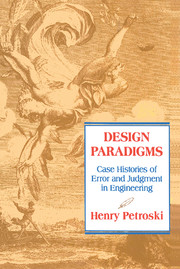Book contents
- Frontmatter
- Contents
- Preface
- 1 Introduction
- 2 Paconius and the Pedestal for Apollo
- 3 Vitruvius's Auger and Galileo's Bones: Paradigms of Limits to Size in Design
- 4 Galileo and the Marble Column
- 5 Galileo's Confirmation of a False Hypothesis
- 6 The Design and Collapse of the Dee Bridge
- 7 The Britannia Tubular Bridge
- 8 Failure as a Source of Engineering Judgment
- 9 The Design Climate for the Tacoma Narrows Bridge
- 10 Historic Bridge Failures and Caveats for Future Designs
- 11 Conclusion
- Bibliography
- Index
7 - The Britannia Tubular Bridge
A Paradigm of Tunnel Vision in Design
Published online by Cambridge University Press: 05 June 2012
- Frontmatter
- Contents
- Preface
- 1 Introduction
- 2 Paconius and the Pedestal for Apollo
- 3 Vitruvius's Auger and Galileo's Bones: Paradigms of Limits to Size in Design
- 4 Galileo and the Marble Column
- 5 Galileo's Confirmation of a False Hypothesis
- 6 The Design and Collapse of the Dee Bridge
- 7 The Britannia Tubular Bridge
- 8 Failure as a Source of Engineering Judgment
- 9 The Design Climate for the Tacoma Narrows Bridge
- 10 Historic Bridge Failures and Caveats for Future Designs
- 11 Conclusion
- Bibliography
- Index
Summary
Not all engineering failures take place suddenly and dramatically, accompanied by the crack and crash of steel and the tragic loss of life. Indeed, some classic errors in design have been all but ignored and forgotten in the context of what are generally hailed as tremendously successful projects. Yet these errors can be no less endemic in the design process, and hence case studies elucidating them can be extremely instructive and valuable for the teaching and practice of design. One class of such errors may be described by the rubric of tunnel vision in design, and like other types of errors, it is best introduced through a paradigmatic case history.
One of the most fruitful examples of the role of failure in the history of engineering design was hailed as a tremendous structural success and stood for 120 years as a monument to its engineer. The Britannia Bridge was to carry the Chester and Holyhead Railway across the Menai Strait, a strategic stretch of water with tricky currents between the northwestern coast of Wales and the Isle of Anglesey. On the other side of Anglesey, at the port of Holyhead, trains from London could meet ferry boats to Dublin. Because the Menai Strait was so important to the British Navy, the Admiralty would allow no bridge that would interfere with shipping during or after construction.
- Type
- Chapter
- Information
- Design ParadigmsCase Histories of Error and Judgment in Engineering, pp. 99 - 120Publisher: Cambridge University PressPrint publication year: 1994



